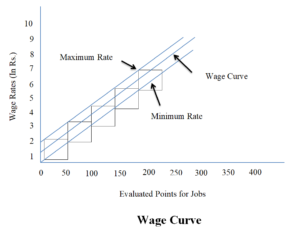Wage determination Process
The wage determination process consists of the following steps:
1. Job analysis
First of all the contents and requirements of a job are analyzed. The data collected through job analysis is used to prepare job description and job specification. On the basis of these statements standards of job performance are laid down.
2. Job evaluation
The relative value of every job is determined through job evaluation. The relative job value is then converted into money value so as to fix basic wage for the job.
3. Wage survey
Wage or salary surveys are conducted to find out wage/salary levels prevailing in the region or industry for similar jobs. Other organizational problems such as recruitment policy, fringe benefits etc. are also considered.
4. Developing wage structure
On the basis of foregoing steps an equitable wage structure is prepared. While determining such a structure several points need to be considered:
i. Legislation relating to wages
ii. Payments equal to, more or less than prevailing wage rates
iii. Number and width of pay grades
iv. Jobs to be placed in each pay grade
v. Provisions for merit increases
vi. Differentials between pay plans and
vii. Dealing with wages/salaries that are not of line with the structure
5. Wage administration rules
Rules are required to determine the degree to which advance will be based on length of service rather than merit, the frequency with which pay based on length of service rather than merit, the frequency with which pay increments will be awarded, the rules that will govern promotions form one pay grade to another, and the way control over wage/salary costs can be maintained. Once the rules are framed these should be communicated to the employees.
6. Employee appraisal
In order to reward merit and performance, it is necessary to evaluate the performance of individual employees. Some differentials in pay are maintained on the basis of employee’s performance. This is necessary to provide incentive for hardwork and superior performance is evaluated against predetermined standards of performance.
The technique of wage curve is often used to develop rate changes. A minimum and maximum rate for each grade (e.g. 10% below and above the wage line) may be decided. The minimum and maximum lines are drawn in the curve. Some overlapping between rate ranges is allowed. Thus, a person who has worked for several years on the job may earn more than a new employee on the next higher pay scale.
7. Broad banding
It is the practice of combining many previously discrete job titles, ranks and pay grades into much wider categories.

